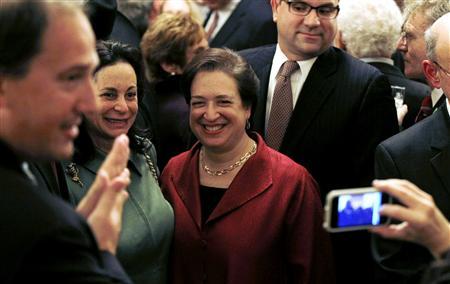(Reuters) – During three days of arguments over the Obama healthcare plan, Supreme Court
Justice Elena Kagan put on a display of rhetorical firepower, reinforcing predictions that the newest liberal justice is best
equipped to take on the conservative, five-man majority controlling the bench.

for a picture with other guests at a Hanukkah reception in the East Room of the White House in Washington, in this December
2, 2010, file photo. During three days of arguments over the Obama healthcare plan, Supreme Court Justice Kagan put on a
display of rhetorical firepower, reinforcing predictions that the newest liberal justice is best equipped to take on the
conservative, five-man majority controlling the bench. REUTERS/Jason Reed/Files
The strong views and persuasive tactics of the administration’s
former top lawyer could affect the fate of the healthcare overhaul, as well as decisions in other ideologically charged
issues that will come before the court, such as same-sex marriage.
Kagan’s sturdy advocacy was evident to law
professors and to lawyers who practice before the court during her first term. But the healthcare debate has offered her a
more prominent platform with bigger stakes. She pressed her argument as ardently as any lawyer who stepped to the
lectern.
At the final session on the final day of arguments, attorney Paul Clement, representing 26 states challenging
the healthcare law, had barely uttered three opening sentences when Kagan pounced.
What followed was one of the most
aggressive exchanges of the entire three days. It centered on a provision expanding eligibility for Medicaid, the joint
state-federal program that pays for poor people’s healthcare. Kagan tried to puncture Clement’s argument that bringing more
people into the program would impinge on states’ sovereignty and further strain their budgets, even though the government
would pick up 90 percent of the cost.
The justice and the lawyer – Kagan a former solicitor general for Obama, Clement
for George W. Bush – went at it for several minutes. When Clement eluded her, Kagan posed trickier scenarios to test the
notion that states are trapped in a program that funnels hundreds of billions of dollars their way yet consumes significant
state funds, too.
“Wow! Wow!” Kagan exclaimed in disbelief, as Clement rejected her hypothetical offers of huge sums
of money, which she posited anyone would accept. The money would not be attractive, Clement responded, if it “came from my
own bank account. And that’s what’s really going on here, in part.”
GROUNDBREAKER, BUT IN A NEW ERA
The
exchange illuminated how Kagan, President Barack Obama’s second Supreme Court appointee, who joined the bench in August
2010, has energized the four-member liberal wing of the nine-member court. A keen strategist, she can also match wits with
Chief Justice John Roberts and Antonin Scalia, the longest-serving conservative on today’s bench.
Her role is
distinct from that of Justice Anthony Kennedy, the conservative who is most likely to swing and occasionally permit the other
side to prevail. Rather than casting a crucial vote, she lends a critical voice that could make the case for liberals within
the court and beyond.
Her approach, seen in her early months and brought vividly to the fore during the healthcare
case, suggests she may be adopting some of the liberal passion of her mentor, Thurgood Marshall, for whom she clerked. He
also served as a solicitor general, during the Lyndon Johnson administration, before becoming the first African-American
justice on the high court.
Marshall, whose tenure spanned 1967-1991, was, with the late Justice William Brennan, a
standard-bearer for a liberalism that has all but disappeared from the federal bench. They opposed the death penalty in every
case, consistently boosted defendants’ rights and favored broad-scale solutions for past racial discrimination. They sought
to give judges a strong hand in remedying social policy disputes.
Kagan is unlikely to embrace that activism of a
bygone era. Yet her approach could lead her to oppose efforts by the conservative majority to reverse past rulings on
race-based remedies, or break new ground on gay rights.
IDEOLOGICALLY CHARGED CASES
Kagan’s fiercest
dissenting opinions on behalf of the liberals have so far come in ideologically charged cases. In an Arizona campaign finance dispute, she wrote that while the
conservative majority said it had found the “smoking guns” at the center of the case, “the only smoke here is the
majority’s, and it is the kind that goes with mirrors.”
“It is absolutely clear. She is positioned to be the leader
on the liberal side,” said Harvard University law professor Mark Tushnet. “It was incredible,” he said of the exchange with
Clement. “She was just not going to let him go. She had the questions all set up.”
In the months preceding the
court’s healthcare hearing, conservative groups and prominent Republicans, including Senate Republican Leader Mitch
McConnell, questioned whether Kagan should sit on the case because she had worked as a high-level lawyer under Obama when the
healthcare law and strategy for its defense was being developed.
The overhaul, which includes a mandate that most
Americans buy insurance by 2014, is intended to bring coverage to more than 32 million uninsured people in the United
States.
Kagan testified during her summer 2010 confirmation hearings that she did not work on healthcare litigation,
and administration officials have since said she was walled off from discussions on how to defend the law. Challengers say
Congress exceeded its constitutional authority with the mandate and Medicaid expansion.
Chief Justice Roberts
implicitly backed Kagan and Justice Clarence Thomas on January 1 when he wrote in an annual report on the judiciary: “I have
complete confidence in the capability of my colleagues to determine when recusal is warranted.” Liberal groups had urged
Thomas not to sit, because his wife, Virginia, a Tea Party activist, has opposed the healthcare law.
HUNTING PHEASANT
AND CRACKING WISE
If anyone had thought Justice Kagan might pull her punches during arguments because of the criticism
she faced for not recusing herself, they were wrong. She defended the Obama healthcare plan with a vigor that might have been
expected if she were still Obama’s first solicitor general.
“I was surprised that she didn’t try to seem a little
more balanced. She was certainly up there with her perspective,” said Carrie Severino, a former law clerk to Thomas who is
chief counsel of the Judicial Crisis Network, a conservative advocacy group that focuses on legal issues and was one of the
organizations that had questioned Kagan’s participation in the case.
Kagan, who declined to be interviewed for this
story, has made friends with colleagues on both sides. The Manhattan native, who as dean of the Harvard law school brought in
more conservative professors to a campus dominated by liberals, has taken up skeet shooting and pheasant hunting with Scalia,
her ideological opposite.
For all her toughness with attorneys who stand before the court, Kagan is also mindful of
her place. Last week she was cut off by senior justices and had forgotten her question by the time her turn came. Quipped the
court’s newest appointee: “See what it means to be the junior justice?”
The views she has brought to the court are
not lost on fellow liberals, particularly veteran Justice Ruth Bader Ginsburg, who since her own 1993 appointment has
witnessed the conservative takeover of the court.
Ginsburg has praised Kagan’s rhetorical skills and “powerful” and
“forceful” opinions – and her use of humor. In a speech in New York last July, Ginsburg cited Kagan’s bench reading of one
of her first court opinions. “If you understand anything I say here, you will likely be a lawyer, and you will have had your
morning cup of coffee.” The daughter of a lawyer and a school teacher, Kagan became the first woman to hold the post of
solicitor general when President Obama selected her in 2009. She had never argued a case before the court but, with her
background in the classroom and navigation of campus politics, she swiftly proved herself a daunting presence. Her style is
one of concise, declarative sentences.
Representing the Obama administration at the lectern, she sometimes clashed
with Chief Justice Roberts. In a case involving potentially competing stances within the Department of Justice, he called her
argument “absolutely startling.” Kagan stood her ground: “The United States government is a complicated place.”
She
has also expressed respect for Roberts. Referring to his years as an appellate lawyer, she referred to him as “the great
Supreme Court advocate of his time.”
STANDOUT DISSENTS
In her first full term, Kagan aligned herself most with
Obama’s only other appointee. According to figures compiled by the SCOTUSblog, a site now partially sponsored by Bloomberg
Law, she voted with Sonia Sotomayor 94 percent of the time, with Ginsburg 91 percent, and Stephen Breyer, the fourth liberal
justice, 87 percent. She was least in accord with Justice Thomas, at 66 percent.
More than her votes, it is her
opinions – mainly in dissent – that have made her stand out. She took the lead to protest a 5-4 decision in an Arizona case
allowing state tax credits that benefited religious schools, insisting the decision “damages one of this nation’s defining
constitutional commitments,” that of religious liberty.
On the last day of the 2010-11 term, Kagan led dissenters in a
separate hot-button Arizona case, as the majority invalidated a state law that gave extra funding to political candidates who
used the public-finance system rather than relied on private backers.
Chief Justice Roberts wrote for the majority.
The dueling opinions revealed the energetic style of the two young leaders: He is 56, she turns 52 this month. When Kagan
wrote that challengers to the Arizona law showed “chutzpah,” Roberts countered, “The charge is unjustified.” As much as they
both employed long citations of law and precedent, they also used punchy two-word sentences. One of his: “Not so.” One of
hers: “Me too.”
SPEAKER FOR THE LEFT
Last week’s healthcare arguments, testing Obama’s major domestic
achievement, illustrated Kagan’s robust approach and her potential to speak for the left.
Advertisement
She jumped in when administration lawyers faltered, responded to conservative justices’
questions about the Obama position, and came on strong when Clement was at the lectern.
During arguments over the new
insurance mandate, premised on the notion that everybody will eventually need medical care, the lead lawyer for the state
challengers said: “The government can’t say that everybody is in that (healthcare) market. The whole problem is that
everybody is not in that market, and they want to make everybody get into that market.”
Kagan replied: Wasn’t that
“cutting the baloney thin? Health insurance exists only for the purpose of financing healthcare. The two are inextricably
interlinked. We don’t get insurance so that we can stare at our insurance certificate. We get it so that we can go and
access healthcare.”
(Editing by Howard Goller and Prudence
Crowther)





